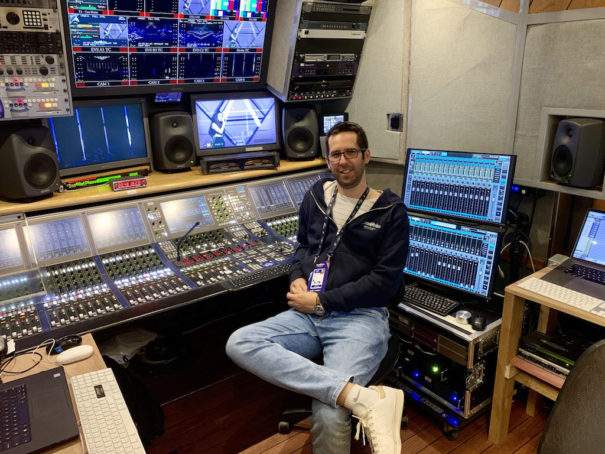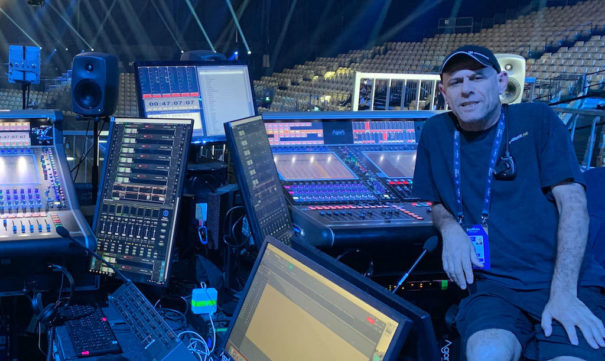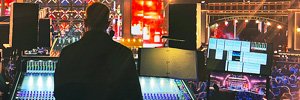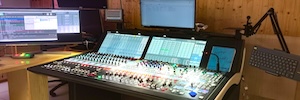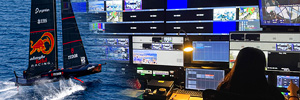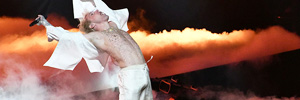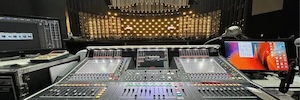Los plugins y el mezclador eMotion LV1 de Waves realzaron el audio en Eurovisión 2019
Para gestionar esta producción combinada de alta gama de escenario/broadcast, que no deja espacio para errores técnicos, los ingenieros Omer Barzilay y Eran Ben Zur recurrieron a las herramientas de Waves para obtener una calidad de sonido superior, además de un funcionamiento y una configuración flexible.
El equipo de sonido en directo del Festival de Eurovisión 2019, capitaneado por los ingenieros Omer Barzilay (Gran Hermano) and Eran Ben Zur (Dweezil Zappa), eligió los plugins de Waves y el mezclador en directo Waves eMotion LV1 para potenciar el sonido del concurso musical que se emitió en directo a más de 200 millones de espectadores.
Emitido desde la Expo de Tel Aviv, del 14 al 18 de mayo, Eurovisión 2019 presentó tres espectáculos en directo (dos semifinales y una gran final) durante tres días, con 41 competidores, cuatro anfitriones en el escenario y numerosos artistas invitados, y con un exclusivo espectáculo en vivo de dos canciones de la estrella invitada Madonna.
Para gestionar esta producción combinada de alta gama de escenario/broadcast, que no deja espacio para errores técnicos, Omer Barzilay y Eran Ben Zur recurrieron a las herramientas de Waves para obtener una calidad de sonido superior, además de un funcionamiento y una configuración flexible.
Omer Barzilay comenta que “los directores de sonido de la producción local de Eurovisión, Yair Goren y Yossi Edri, sugirieron que el ingeniero de Pro Tools/LV1, Jonathan Jacobi, y yo mismo, lo mezcláramos todo en la mesa Waves eMotion LV1. Estaba absolutamente encantado de poder utilizar los plugins de Waves de una manera tan fácil y flexible, ejecutando los plugins directamente en el mezclador de software. Para mí, Waves es la elección obvia para la mezcla de emisiones, así que esa fue la solución perfecta. Además, cuando se trata de la transmisión, por lo general se busca redundancia del sistema y copias de seguridad; eMotion LV1 proporcionó precisamente eso. Es una clara ventaja tener un sistema basado en software: pudimos crear fácilmente dos sistemas idénticos con dos servidores Waves SoundGrid cada uno, y creamos aún más copias de seguridad en nuestros portátiles personales”.
Ganando tiempo
Barzilay continúa afirmando que “una de las mayores ventajas de usar el LV1 es que pude mezclar la mayoría de las canciones antes de tiempo. Estaba mezclando alrededor de un mes y medio antes del show, en mi estudio, enviando todos los temas que recibí de antemano de Pro Tools a eMotion LV1, creando todas las automatizaciones y efectos para que estuvieran listos para el show. El tiempo es crucial cuando se mezclan tantas canciones diferentes para un evento musical tan inmenso, y si no hubiera usado un mezclador de base de software, nunca hubiera podido estar preparado de esta manera”.
Barzilay añade, acerca de su flujo de trabajo, que “durante el espectáculo dirigimos todo el audio al mezclador eMotion LV1 y a un ordenador de grabación multipista. Utilizamos la entrada A/B del mezclador LV1 para volver a encaminar la grabadora, de modo que pudiéramos continuar mezclando el show entre tomas. Esto fue muy rápido, y tan pronto como una delegación terminó su primera toma, seguimos mezclándola hasta la siguiente. No perdimos el tiempo”.
“Mis contactos son el Scheps Omni Channel, que fue lo único que utilicé para todas las voces, incluyendo de-essing, EQ, compresión y saturación. En las voces principales, el compresor multibanda Waves C6 era extremadamente valioso para controlar las frecuencias altas y bajas y para controlar los chasquidos y silbidos. También usamos el plugin Waves Dugan Automixer para todos los micrófonos de los anfitriones e invitados. El H-Reverb Hybrid Reverb de Waves es mi reverb principal: usamos seis ejemplos. Dicho esto, también utilizamos el Waves IR1 Convolution Reverb y el Renaissance Reverb. Mi principal retardo es el Waves H-Delay Hybrid Delay, que utilicé para alrededor del 90 por ciento de los retardos en esta producción. Además, utilicé el Manny Marroquin Delay para la separación de L/R. Finalmente, la cadena de masterización TG de Abbey Road estaba en nuestra cadena maestra: TODA la música se dirigía a través de ella”, señala sobre el uso de los plugins de Waves.
“La mayor ventaja de la Waves eMotion LV1”, resume Barzilay, “es que puedes llevar tu estudio contigo a eventos en directo. Algunos de los plugins son efectos que he estado usando durante las últimas dos décadas”
El ingeniero de mezclas de FOH Eran Ben Zur comenta sobre su flujo de trabajo y el uso de los plugins de Waves: “Cuando se mezcla un programa en vivo que se transmite a más de 200 millones de personas, un ingeniero de FOH debe combinar dos objetivos principales: Es necesario mezclar el espectáculo para los 8.000 espectadores sentados en el estadio, logrando el nivel de presión sonora adecuado para garantizar que el público reciba la cantidad adecuada de energía sónica. Pero también hay que asegurarse de que el PA no interrumpa una transmisión limpia y clara”.
La configuración FOH incluía dos consolas DiGiCo SD7 con configuraciones Waves MultiRack SoundGrid que complementan cada consola, servidores Waves SoundGrid Extreme y pantallas táctiles para ejecutar los plugins Waves, además de dos interfaces de audio DiGiGrid MGB y dos ordenadores Mac que ejecutan Waves’ Tracks Live DAW para la grabación multipista.
“Uno de los retos del espectáculo -explica Eran- era mezclar no sólo la música, sino también los micrófonos de los cuatro presentadores que interactúan en el escenario. Para ello, utilicé el Expansor de Fuente Primaria (PSE) de Waves y los plugins de eliminación de retroalimentación X-FDBK”, concluye Eran Ben Zur.
Did you like this article?
Subscribe to us RSS feed And you will not miss anything.



